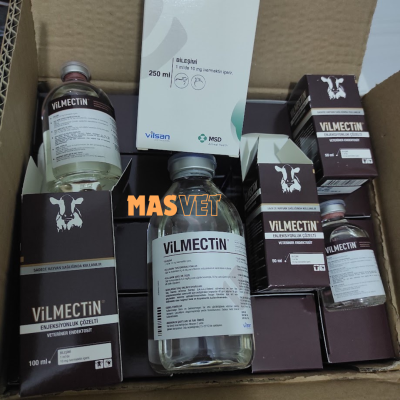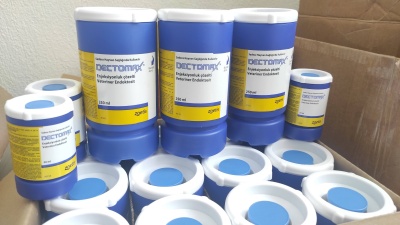baytril oral 100 ml
BAYTRIL 2.5% - oral
COMPOSITION:
1 ml transparent solution contains 25 mg Enrofloxacin.
Baytril 2.5% Oral Solution
Species:Cattle, Ornamental birds, Rabbits, Reptiles, Small mammals
Therapeutic indication:Pharmaceuticals: Antimicrobials: Oral preparations: Others
Active ingredient:Enrofloxacin
Product:Baytril 2.5% Oral Solution
Product index:Baytril 2.5% Oral Solution
Cattle - meat:8 days
Withdrawal notes:Not for use in poultry (chickens and turkeys). Not for use in exotic animals or birds intended for human consumption.
PHARMACOLOGICAL PROPERTIES:
Enrofloxacin, the active ingredient of Baytril 2.5% oral solution, is a fluoroquinolone group of antibiotics and is an antibacterial drug with a particularly high bactericidal effect. The broad spectrum of antibacterial activity of this substance includes mycoplasmas, gram-negative and gram-positive bacteria as well as aerobic pathogenic bacteria. Enrofloxacin affects the bacterial gyrase enzyme, which plays an important role in the reproduction of DNA, and prevents it from doing its job. Inhibiting this enzyme causes functional disorders by blocking certain periods of bacterial synthesis; This leads to the death of the bacteria. Main susceptible bacteria: E. coli, Salmonella sp., Enterobacter sp., Serratia sp., Proteus sp., Klebsiella sp., Shigella sp., Yersinia sp., Moraxella sp., Acinobacter sp., Actinobacillus sp., Pasteurella sp., Leptospira sp. ., Citrobacter sp., Haemophilus sp., Ehrlichia sp., Coxiella brunetii, Staphylococcus sp., including those resistant to methicillin and gentamicin, N. gonorrhoeae, including those resistant to penicillin, N. meningiditis, Corynebacterium sp., Chlamydia sp., V .cholerae, Mycoplasma sp. Strep. suis, Strep. agalactia, Strep. dysgalactia, Strep. zooepidemicus,
R. equi, Mycobacterium sp. It shows moderate sensitivity.
Most anaerobic cocci, Clostridium sp., Bacteroides sp. and Ps. maltophila is generally less sensitive or resistant to quinolones.
Baytril reaches its maximum serum level 0.5-2 hours after application, regardless of the application method, and remains at the same therapeutic level for 24 hours. Due to its lipophilic properties, enrofloxacin penetrates lipid-containing tissues well. It is particularly effective in the treatment of intracellular infections due to its ability to accumulate in phagocytes. Biotransformation occurs in the liver. Enrofloxacin is excreted unchanged or converted to ciprofloxacin and other quinolone metabolites in feces and urine.
At the end of the research, the LD50 value for rats was determined to be 2000 times the therapeutic dose (2.5 mg/kg).
INDICATIONS/AREA OF USE:
Sensitive gram-negative and gram-positive bacteria and Mycoplasma sp. in lambs and calves whose rumen activity has not started. It is used in the treatment of respiratory and digestive system infections, other soft tissue infections and secondary bacterial infections accompanying viral infections caused by It is indicated for major Mycoplasma infections (such as infectious pleuropneomonia in cattle, agalaxia in sheep), E. coli infections (such as Colibacillosis, Colisepticemia), Salmonellosis (Salmonella abortion and enteritis), and Pasteurellosis infections.
APPLICATION METHOD AND DOSAGE:
Unless otherwise recommended by the veterinarian; The recommended dose of Baytril 2.5% oral solution is 2.5 mg/kg body weight per day for 3 days. It is recommended only for severe upper respiratory system diseases and Salmonellosis, at a dose of 5 mg/kg body weight per day for 5 days. The medicine is given to the animal either directly or by mixing it with any liquid (water, etc.) (it should not be mixed with milk). The normal dose is 1 ml for every 10 kg live weight of the animal. If the animal has severe respiratory disease or salmonellosis, this dose is 2 ml for every 10 kg of live weight.
Thanks to the pump mounted on Baytril 2.5% oral 100 ml bottles, 1 ml of oral solution is given with each press. The tip of the pump is placed towards the oral cavity and throat and pumped according to the dose.
SPECIFIC CLINICAL INFORMATION AND SPECIAL WARNINGS FOR TARGET SPECIES:
It should not be used for systemic treatment in lambs and calves whose rumen activity has started due to its negative effects on the rumen flora.
UNDESIRABLE/SIDE EFFECTS:
Quinolones may rarely cause convulsions. Therefore, it should be used with caution in patients with known or suspected central nervous system disorders. Some quinolones, such as ciprofloxacin and enrofloxacin, can sometimes cause crystallization in the urinary tract. Therefore, water restriction should not be made while giving these medications.
DRUG INTERACTIONS:
Concomitant use of enrofloxacin with other drugs known to be metabolized in the liver may affect the pharmacokinetics of these drugs. Quinolones prolong the half-life of theophylline, coumarin derivatives, methyl xanthines and non-steroidal analgesics. In the same direction (synergistic) between fluoroquinolones and aminoglycosides, beta-lactam drugs and sulfonamides; There are antagonistic interactions between phenicols, erythromycin, polymyxin, nitrofurantoin and rifampin.
WARNINGS FOR DRUG RESIDUES IN FOOD:
Drug Residue Withdrawal Time (i.k.a.s.); During the treatment and before 8 days following the last drug use, calves and lambs should not be sent to slaughter until 10 days later.
CONTRAINDICATIONS:
Its use is contraindicated in those with liver and kidney failure.












